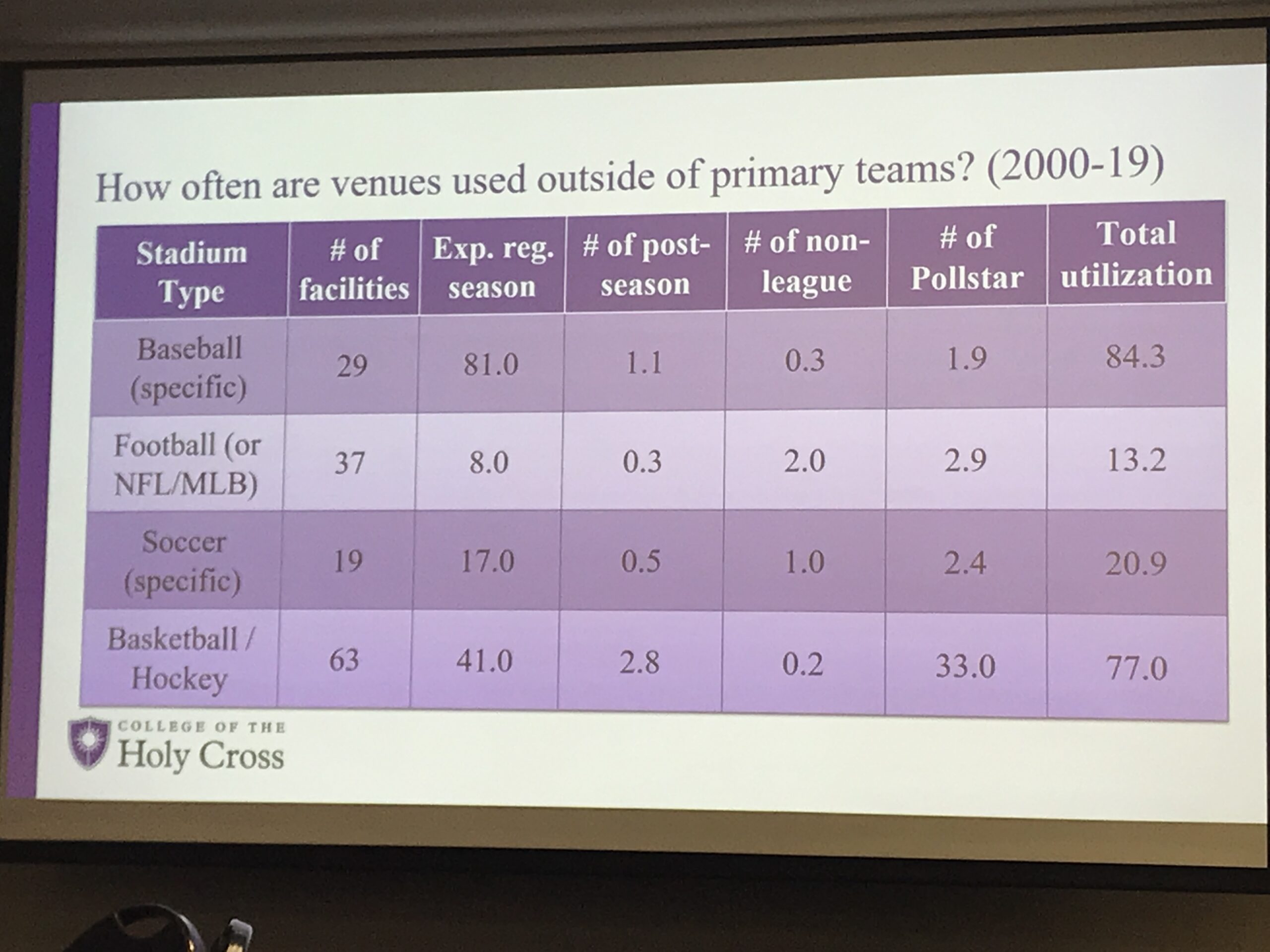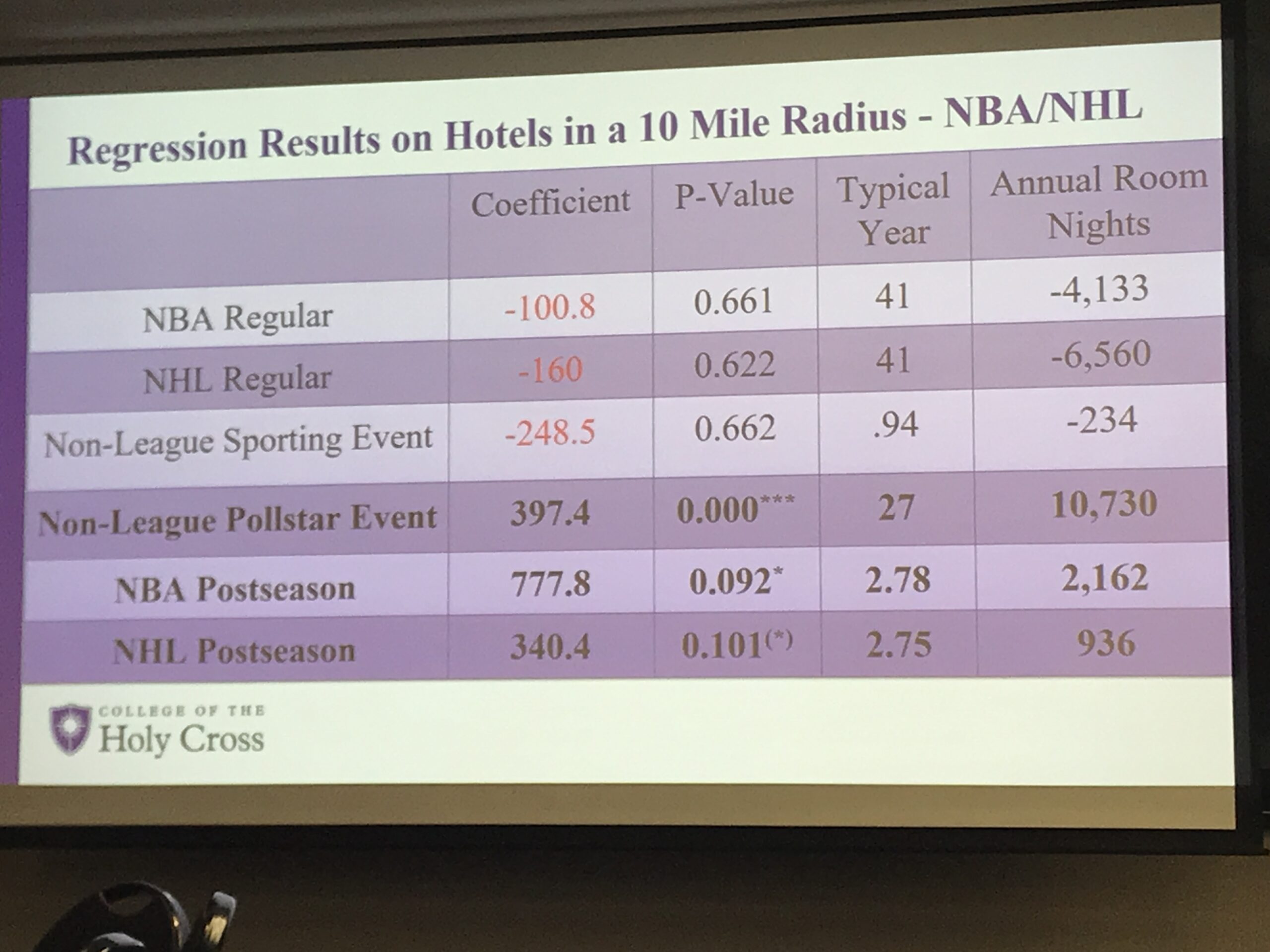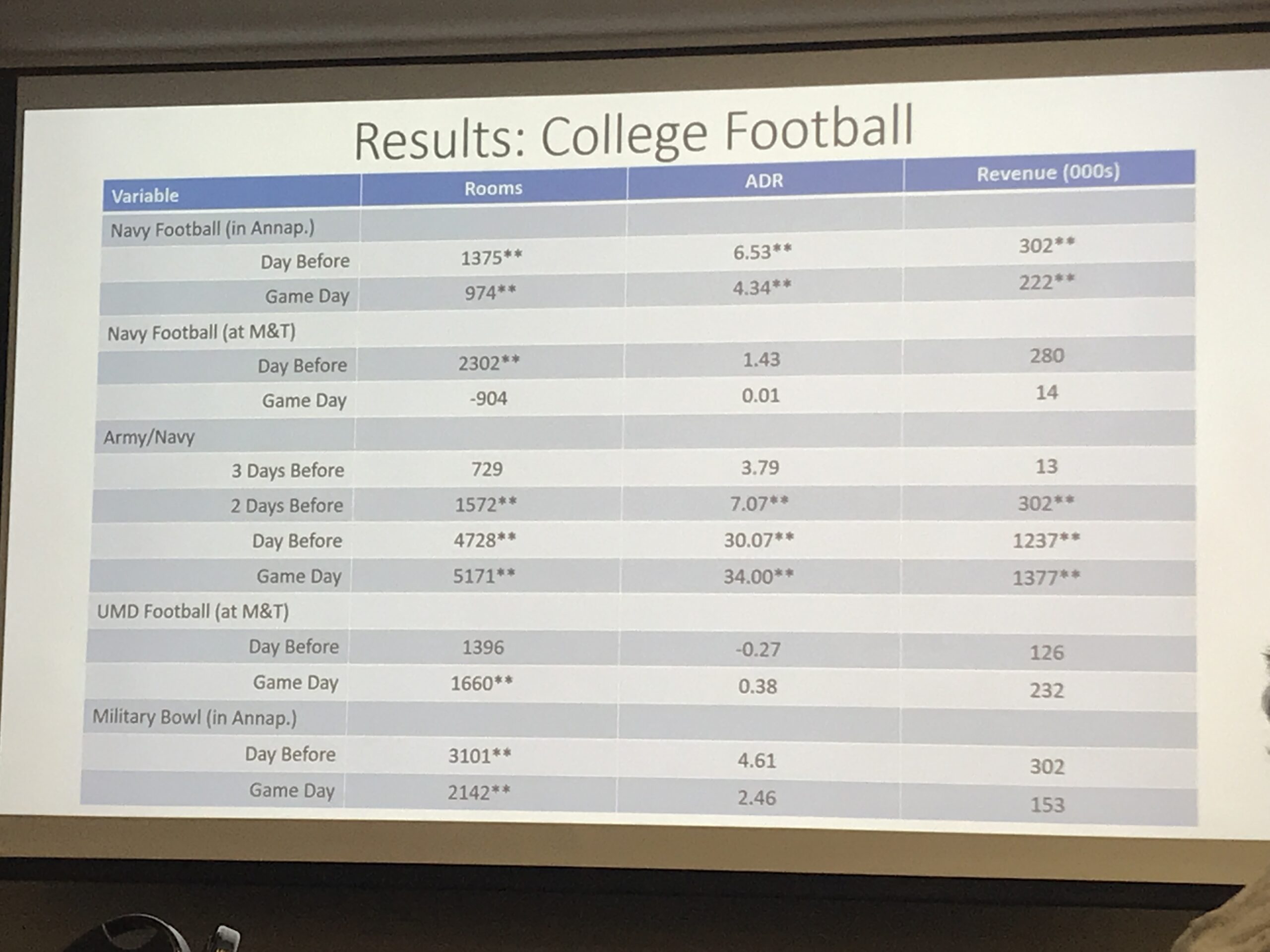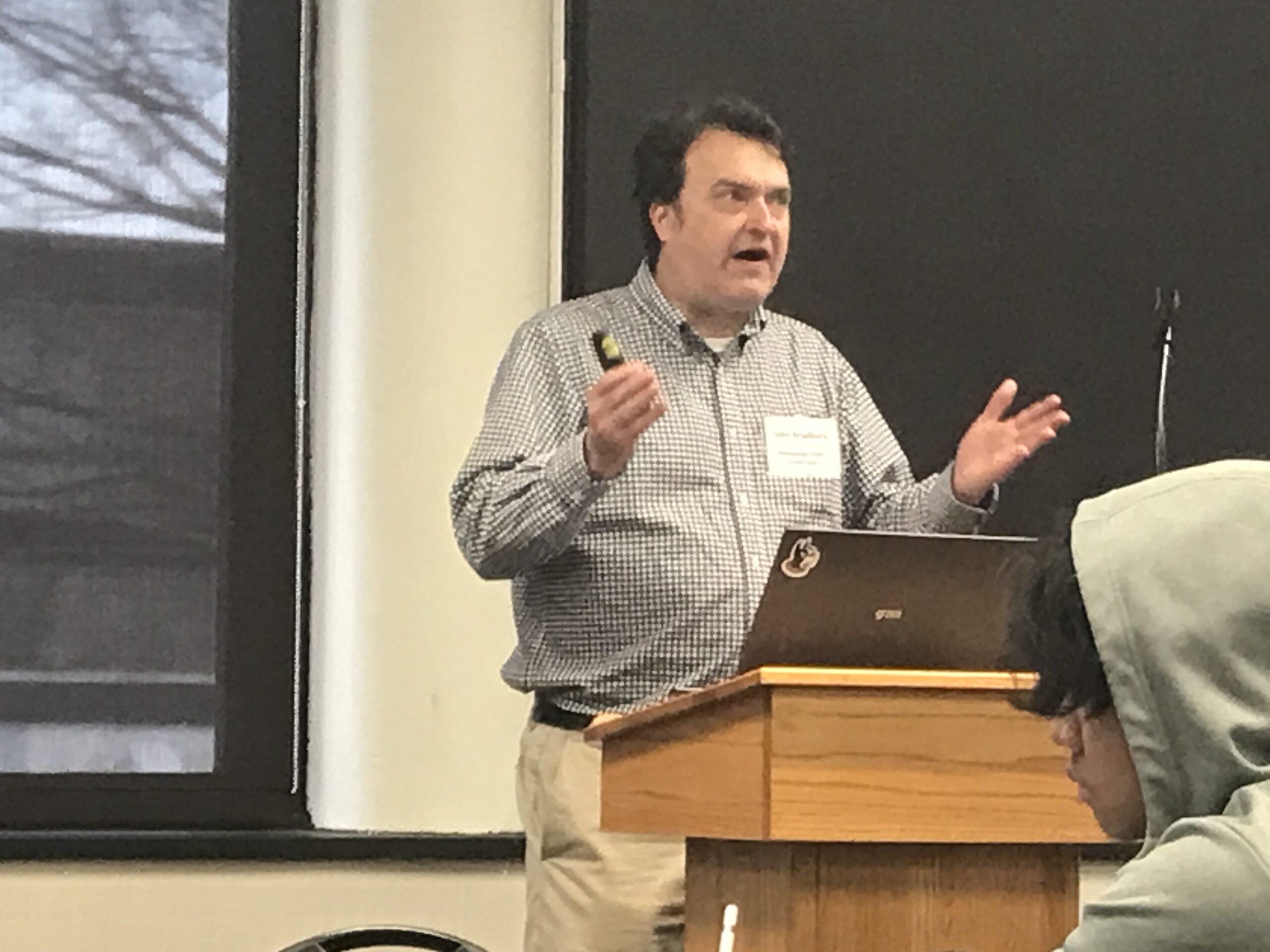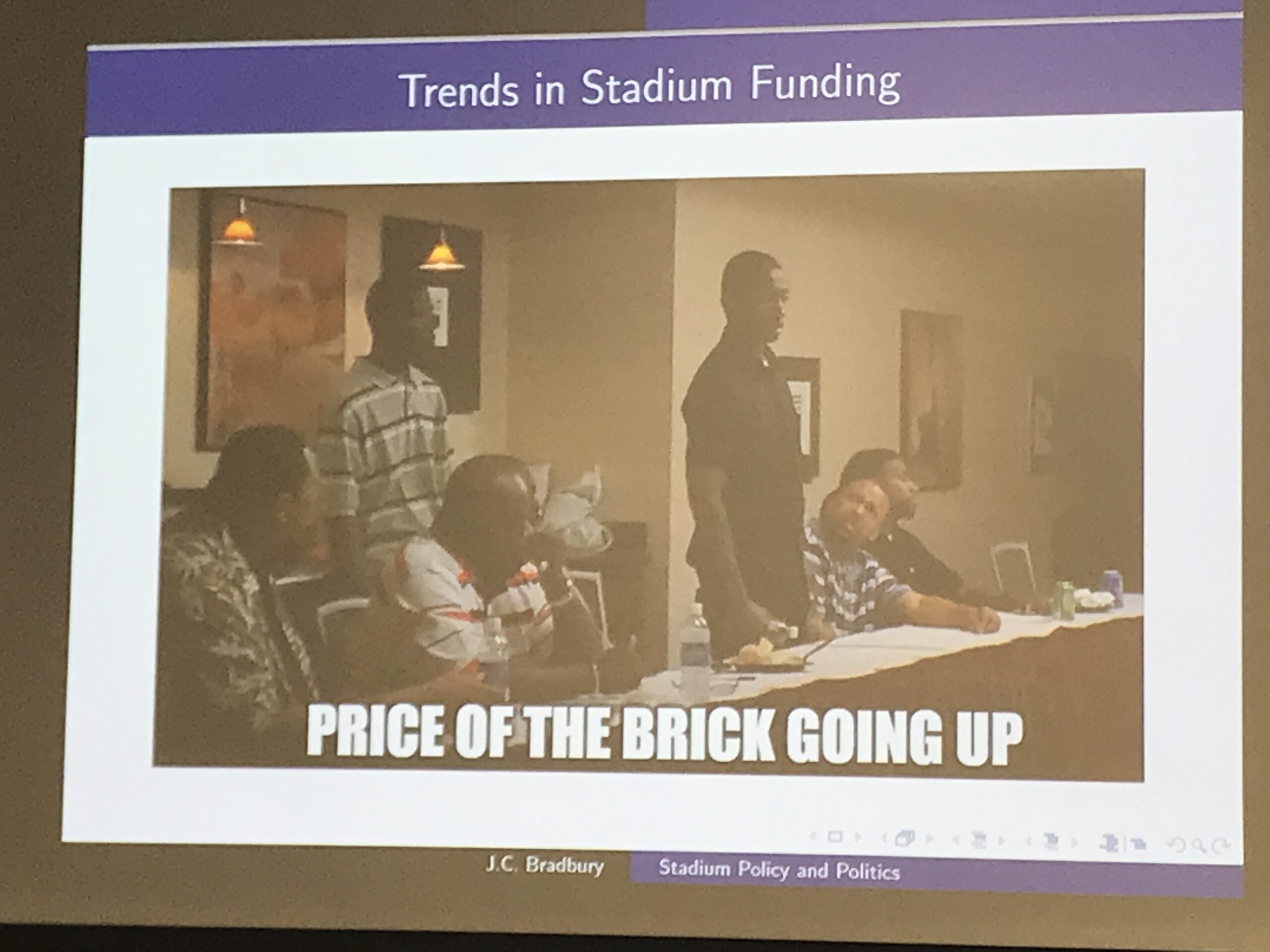Day two of the sports economics conference at the University of Maryland-Baltimore County! We’ve got a packed day of presenters and we all got lost in campus construction on the way to the meeting room, so let’s go go go:
First up is J.C. Bradbury, who should need no introduction, speaking on “Franchise Relocation and Stadium Subsidies: Credible Threats or Cheap Talk?” Why do we still have so many stadium subsidies when they’re so pointless? he asks. Because sports leagues drive cities into bidding wars. The obvious answer, then: Figure out how to remove leagues’ monopoly power so they can no longer have cities over a barrel.
All that makes sense in theory, says Bradbury, but “in practice, it doesn’t seem to predict so well.” By now, pretty much every major-league market is filled, making move threats far less credible:

And when teams do leave, markets often get them back: Of 20 cities that lost teams since 1990, nine of them have already gotten replacements.
Yet the amount of money going to sports venues keeps going up. WTF? (Paraphrasing there.)

“None of these teams threatened to move, except for the Washington Wizards and Capitals.” And those teams, he notes, were told “to go jump in the lake” by both Virginia and Maryland; at which point “they walked back across the Potomac and asked for $500 million and were told ‘sure.’ They literally did not have anywhere to go and they got $500 million in subsidies!”
Looking at Chicago White Sox owner Jerry Reinsdorf’s campaign for a new stadium in the late 1980s, you can see how move threats are created out of whole cloth by a combination of team ownership and supportive elected officials:

Eventually, legislative leaders were able to get the stadium subsidy passed, with the help of stopping the clock in the meeting room to get around a midnight deadline — and with the help of the move threat that the governor himself had asked for. “Jerry Reinsdorf was never going to move the team,” says Bradbury. “He basically admitted it later.”
A similar scenario played out with the recent Buffalo Bills stadium, where news headlines said “everyone knew” that the team could leave, with no specific cities mention. And for good reason:

The fact that this continues to go on — despite expansion filling more and more cities — shows that the problem isn’t bidding wars. It’s that elected officials are handing over public cash regardless of whether move threats are real. Bradbury then showed a series of slides (no photos, sorry, they went too fast) showing elected officials in Atlanta standing with Braves players or wearing Braves jerseys.
Bradbury’s proposed solution: more voter referendums, because “you can’t fit a majority of the electorate in the owner’s box.” Then he closed with a Simpsons meme, just for me, and by extension you, FoS readers:

To a question about why voters don’t penalize elected officials, Bradbury says they do: Way more politicians are voted out of office for approving stadiums than for letting teams leave: “[Cobb County commissioner] Tim Lee was absolutely floored when he lost his election, because everyone around him loved it.”
More to come when this forms the centerpiece of a chapter in Bradbury’s upcoming book, watch for it coming soon!
Presenter #2: Frank Stephenson on how Taylor Swift’s presence at Kansas City Chiefs games affected TV viewership. There are many equations with Greek letters, but the upshot is: Viewership went up by about a third after Swift started showing up. This could be a potential gold rush for sports leagues, notes Stephenson, if they comp more tickets for superstars to get them to attend games — assuming they can identify other Taylor Swifts, that is, which could be a challenge.
(Major points to this presentation for using the mathematical term “Swift variable.”)
Up next is Shirin Mollah, presenting preliminary data on the impact of U.S. stadium on local labor markets. Looking at Texas and Ohio, she found that there are more new job listings in cities with stadium openings, though she still needs to look at more locations, over longer time periods, and related to specific events.
Paul Holmes follows, with the intriguingly titled “Moneyball, Body Mass, and Salary for MLB Hitters.” Previous studies have found mixed results as to whether Moneyball influenced things like on-base percentage in MLB; but Billy Beane also pointed out in the book Moneyball (which, to be clear, he did not write) that baseball teams overvalue “looking like” a baseball player. Have teams been more open to signing players of, shall we say, non-standard body-mass indexes since then?
The standard Lehman baseball database only looks at player weights once in their careers, so instead Holmes turned to an alternate data source:

Looking at weights on baseball cards, teams penalized overweight baseball players with lower salaries before Moneyball, but now they’re treated the same as their lower-BMI teammates. Rationality! Unless, as several questioners noted, BMI is a bad metric entirely, because you can’t tell flabby players from musclebound ones.
(This had nothing to do with stadiums, but it had baseball cards in it, so I’ll allow it.)
Next presenter is Jeff Carr on “But For? The Ballpark District and San Diego’s Investment.” Conference organizer Dennis Coates notes ahead of time that Carr is going to argue that “there is an economic benefit of stadiums,” so this presentation should be interesting, as should the Q&A at the end.
The Ballpark District is the redevelopment area around the San Diego Padres stadium, approved by voters in 1998. A previous paper (presented by Carr last year) estimated that the TIF district siphoning off taxes from the stadium district was enough to pay off the public costs; but can it be shown that that money would not have rolled in but for the Padres stadium?
The resulting analysis dove heavily into stats jargon (it took me a minute to realize Carr was saying “covariates” and not “covariants,” which are two different things), but cutting to the chase: Property values went up a lot more in the ballpark district than it would have absent the stadium. And looking at the alternate proposed stadium sites, they didn’t see a big rise in property values until many years after the Padres stadium was opened.
You probably see one problem here: Sure, the ballpark district got more stuff built, and more property taxes paid, because it was a ballpark district. (Assuming the model of what would have happened but for the stadium is accurate.) But does that mean that the city of San Diego actually got more overall tax revenues as a result? Or did the district just siphon off development that would otherwise have gone to other parts of the city? Carr agrees: “Just because we build a ballpark doesn’t mean we’re pulling money out of thin air” — for the county or metropolitan area as a whole, it’s likely all substituting for economic activity that would have happened elsewhere.
Geoffrey Propheter, who notes that he “eats, sleeps, and breathe property taxes,” has another concern, speculating that “what you’re actually measuring is this dot-c0m property appreciation push that’s happening at the same time” as the stadium construction. Carr agrees that’s a possibility.
We are getting tantalizingly close to lunch.
But first: Veronika Dolar on whether income inequality between countries impacts Olympic success. Her conclusion: Yes, athletes from countries with more income inequality do significantly worse in the Olympics, both because it’s hard to train like Michael Phelps if you can’t afford good food to begin with and because it’s tough to train as a bobsledder if you can’t afford a bobsled.
Lunchtime! More later.
Keri Rubinstein and her co-author (whose name I was too slow on the keyboard to record, apologies) looked at whether hosting part of the Tour de France has political benefits for city officials. Takeaway: “What we find is a whole lot of nothing. It’s robustly nothing too!” Memo to French mayors who might think they can point to their successfully landing a Tour de France stage to win votes next election: Ouais, non.
One of the highlights of this conference was going to be hearing Judith Grant Long (of stadium hidden cost fame) speak about her research into community benefits agreements in stadium and arena deals, but Long’s mother broke her hip yesterday, so instead her student Robert Sroka presents their paper. (You are very much missed here, Judith.) CBAs, he explained, are seen as ways for grassroots groups to extract benefits from a major development deal; and developers see it as a way to head off opposition by spending a few extra bucks. (I’ve written about CBAs myself here and here.)
“Community benefits” can be anything from parks to free tickets to opening new grocery stores, and Long has compiled data on all of these. A couple of sample slides:


A couple of overarching points:
- CBAs are increasing in popularity, and are now the standard in both MLS and the NBA.
- CBAs shouldn’t be assumed to be benevolent contributions — these are part of the political sausage making, and should be seen as such.
Question time!
- “Is this just a legal form of bribe to leaders who claim to represent the grassroots?” Yup, can be.
- How often do CBA signatories promise things and never deliver on them? Judith would know that.
- Can we see a time graph of how many projects have had CBAs each year? “I believe Judith has a histogram in the works in the draft paper.
- Why so many CBAs for MLS stadiums? It possibly has to do with so many MLS stadiums being sold to the public as community development projects.
Moving on, another economist well-known to readers of this site: Geoffrey Propheter, speaking on determining what factors predict whether lawmakers will or won’t support sports venue subsidies. More specifically:
- Are Democrats or Republicans more likely to support subsidies?
- If not, what does predict their behavior?

Propheter notes that there’s a selection bias here: “We only see votes for bills that make it through the process.” (In his stats, zero stadium and arena subsidy bills were voted down, because they just never made it to a final vote.) As Propheter has reported before, that’s very much not the case for public referenda:

Ideologically, Propheter notes, both parties have reasons to vote against sports subsidies: Democrats because it’s giving a ton of public money to billionaires, Republicans because it’s a huge intervention in the free market. But sports subsidy votes turn out to not be very party-line — and, importantly, don’t seem to carry a lot of weight in terms of whether voters will re-elect you. (Especially if you’re term-limited anyway.)
Some more findings:
- Republicans, it turns out, are about 10% more likely than Democrats to oppose sports subsidy votes, though it’s more like 7% if you account for more variables. And legislators of both parties approve these bills overwhelmingly, so a 7% difference isn’t a huge amount.
- Younger Democrats are much more likely to oppose sports subsidies than older ones; for Republicans, age doesn’t matter at all.
- The most important variables predicting whether legislators will oppose a deal are how far they are from the site, how young they are, if they’re female, and if they’re more politically experienced. (Translation: The best friend a sports owner can have is an old dude who represents the stadium district and is new to politics.) In particular, term limits may make subsidies worse, because elected officials are more likely to have never thought about sports subsidies before, and also more likely to not care what their constituents want because they just care about having a physical legacy.
Coates suggests looking at 1) how officials are voting relative to what their constituents want and 2) which way legislators went in votes earlier than the final one, since there could be useful information there. (He agrees that doing either of these well is a challenge.)
Propheter says he’ll have more data down the road: He’s planning to spend the next five years compiling data for all votes since 1970. Everyone agrees to meet back here in 2030.
If you’ve read this far, I imagine you’re running out of steam, because I sure am. Let’s go to bullet points from here:
- Mollah presents her second paper of the day, this one on whether English soccer teams that win create more jobs: Cities whose teams got promoted turned out to have more job listings after the fact, whereas those with teams that got relegated saw no impact. She then got into a heated discussion with soccer economist Stefan Szymanski about whether including very lower-level league teams like Grimsby Town F.C. (which is about the most lower-level English soccer team name imaginable) made any sense, since even if they get relegated, they can’t lose many fans, since they don’t have that many to begin with.
- Zhaosheng Li presents on how NBA players learn from their teammates, and there were so many Greek letters. Not to mention Euler equations. It comes down to the fact that players will take less money to play with better teammates and learn from them (or, as a commenter noted, have a shot at a championship) and … yeah, this is all above my mathematical pay grade and seemingly mostly a theoretical model, I’m taking a mulligan here.
- Scott Kaplan speaks on how much suspense and surprise affect viewership of NBA games. (“Suspense is really just expected surprise” went one explanation of terms.) One conclusion seems to be that people enjoy surprise but suspense is more likely to keep them watching, which, that tracks.
- Coates presents a paper called “On the (mis)interpretation of hedonic price coefficients of stadium amenity values,” which he prefaces as being in kind of half-baked shape and basically an “Old Man Yells at Cloud” response, but plunges on ahead: Consultants say stadiums make everyone happier; economists say that’s nonsense. There’s an argument that property values go up near stadiums because people like stadiums — but could it also be because the stadium just took a huge chunk of property off the market? More research needed, which is what Coates is calling for.
- Jonathan Jensen talks about Formula One and sponsorships, finding that since F1 changed its point system in 2010, when one team runs away with a championship, sponsors are way more likely to drop their teams as a result.
- And finally, Stefan Szymanski, who haters of my “Is MLS a Ponzi Scheme?” article in Deadspin way back when will recall as one of the economists arguing that that league had overly inflated franchise values, presents on “Root, root, root for the home team: Did TV kill minor league baseball?” Short answer: Yeah. Long answer: Yeahhhhhhh. (A similar effect is seen with lower-division soccer in the UK, though those teams didn’t fold.) Basically, minor league baseball was a viable option when there was nothing else to do, but television gave people a constant stream of things to do, for free, and that was that — especially when there was no hope for promotion to a higher league as there was in British soccer.
And that is that — we’re done, in every sense of the word. Thanks for reading, and I hope this was … entertaining? Informative? Instructive as to what economists do when packed into a room with each other? Any of those, really. See you back here on Monday for our regularly scheduled doomscroll.




